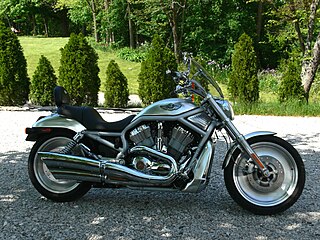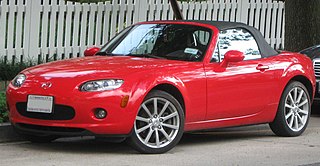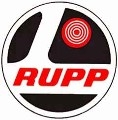
The Lamborghini Diablo is a high-performance mid-engine sports car built by Italian automobile manufacturer Lamborghini between 1990 and 2001. It is the first production Lamborghini capable of attaining a top speed in excess of 200 mph (320 km/h). After the end of its production run in 2001, the Diablo was replaced by the Lamborghini Murciélago. The name Diablo means "devil" in Spanish.
The Honda XR series is a range of four-stroke off-road motorcycles that were designed in Japan but assembled all over the world.

A minibike is a two-wheeled, motorized, off-highway recreational vehicle popularized in the 1960s and 1970s, but available continuously from a wide variety of manufacturers since 1959. Their off-highway nature and typically entirely off-road legal status differentiate minibikes from motorcycles and mopeds, and their miniature size differentiates them from dirt bikes.

In the market, there is a wide variety of types of motorcycles, each with unique characteristics and features. Models vary according to the specific needs of each user, such as standard, cruiser, touring, sports, off-road, dual-purpose, scooters, etc. Often, some types like sport touring are considered as an additional category or integrated with touring.

First introduced in 2003, the Ducati Multistrada is a series of V-twin and V4 touring focused motorcycles. Essentially a hybrid of a supermoto and a sport-tourer, the Multistrada competes in the market with other dual-sport motorcycles such as the BMW GS. The first iteration of the Multistrada was, like the Yamaha TDM850, neither intended nor suitable for off-road use. Subsequent models were more suited to a proper dual-sport role.

The Harley-Davidson Sportster is a line of motorcycles produced continuously since 1957 by Harley-Davidson. Sportster models are designated in Harley-Davidson's product code by beginning with "XL". In 1952, the predecessors to the Sportster, the Model K Sport and Sport Solo motorcycles, were introduced. These models K, KK, KH, and KHK of 1952 to 1956 had a sidevalve engine, whereas the later XL Sportster models use an overhead valve engine. The first Sportster in 1957 had many of the same features of the KH including the frame, fenders, large gas tank and front suspension.

Mini Choppers are scaled-down versions of custom-built motorcycles known as choppers. Commercially available Mini Choppers are available from various retailers, some utilizing similar production methods to Minibikes, while others use Scooter, Moped sourced parts/engines. Custom Mini Choppers are generally constructed from 1" steel tubing or 3/4" steel black pipe. The tube or pipe is bent and then welded together to get the desired angles and shapes of the frame.

The Tote Gote is an off-road motorcycle that was produced from 1958 to 1970. It was developed by Ralph Bonham.

The R60 and R60/2 are 600 cc boxer-twin that were manufactured from 1956 to 1969 in Munich, Germany, by BMW.

Pocketbikes are small, two wheeled recreational vehicles approximately one-quarter the size of a regular motorcycles, and are powered by two-stroke internal combustion engines of between 40 and 50 cc. Pocketbikes maintain the look of full-sized sport bikes and are known outside of North America for racing on specialty tracks designed for small Power Sport machines. These specialized models, designed for competition, produce up to 17 hp, and have front and rear suspension akin to larger sport bikes. Most consumer models are far less powerful, usually below 3hp, and do not feature suspension, relying on the tires alone for shock-absorption. Weight for most machines are approximately 50 lb (23 kg). The usual height is less than 50 cm (20 in), and up to 1 m length.
Motorcycle components and systems for a motorcycle are engineered, manufactured, and assembled in order to produce motorcycle models with the desired performance, aesthetics, and cost. The key components of modern motorcycles are presented below.

The Harley-Davidson VRSC, or V-Rod, is a line of V-twin cruiser motorcycles made by Harley-Davidson from 2002 until 2017. They are often called muscle bikes for their relatively high power output. The V-Rods are the first street motorcycles made by Harley-Davidson with overhead camshafts and liquid cooling.

The BMW R65 is a light touring motorcycle introduced by BMW in 1978 to add a mid-size motorcycle to its product line. The original R65, contrary to the views of some commentators, has the same sized frame as the larger R series motorcycles. The R65 does however have a shorter swingarm than its siblings and therefore a shorter bolt-on rear sub-frame; this, along with the shorter front forks and 18" front wheel, gives the illusion that the R65 frame is smaller. The initial model R65 was manufactured until 1984. In 1985 the R65’s engine was put into the same frame and suspension as the R80 which featured a single rear shock absorber (mono-shock). Additionally, between 1981 and 1984, the R65LS was manufactured. This R65 variant has a small triangular fairing that was designed by Hans Muth.

A wheelie bike, also called a dragster, muscle bike, high-riser, spyder bike or banana bike, is a type of stylized children's bicycle designed in the 1960s to resemble a chopper motorcycle and characterized by ape hanger handlebars, a banana seat with sissy bar, and small wheels. Notable examples include the Schwinn Sting-Ray and Krate lines and the Raleigh Chopper line. Other notable manufacturers and retailers that offered models include AMF, CCM, Columbia, Huffy, Iverson, J. C. Penney, Malvern Star, Monark, Murray, Ross, Sears, and Vindec.

The following outline is provided as an overview of motorcycles and motorcycling:
Ala Kart is a custom car, a customized 1929 Ford Model A roadster pickup, built by George Barris, Richard Peters, and Mike "Blackie" Gejeian in 1957. Originally owned by Peters, it is a two-time winner of the Grand National Roadster Show "America's Most Beautiful Roadster" (AMBR) trophy and Hot Rod cover car in October 1958. Featured in hundreds of car shows, Ala Kart has won more than 200 trophies. It has also made numerous appearances in movies, usually in the background of drive-in shots, and dozens of magazine articles since. It is considered by many to be "one of the most iconic hot rods ever built."

The Ducati Scrambler is a V-twin engined standard or roadster motorcycle made by Ducati. The Scrambler was introduced at the 2014 Intermot motorcycle show, with US sales beginning in 2015, in seven configurations: the 803 cc (49.0 cu in) Classic, Urban Enduro, Icon, Flat Track Pro, Full Throttle, Italia Independent and the 399 cc (24.3 cu in) Sixty2.

The Mazda MX-5 (NC) is the third generation of the Mazda MX-5 manufactured from 2005 to 2015. At its introduction in 2005, it won the Car of the Year Japan Award and made Car and Driver's 10Best list from 2006 to 2013.

The Ducati 250 Scrambler, known in Europe as the Ducati 250 SCR is an on/off-road 249 cc (15.2 cu in) single cylinder bevel drive SOHC motorcycle produced by the Italian manufacturer Ducati from 1962 to 1974. Originally produced for the American Market at the request of the US importers, Berliner Motor Corporation, the model was offered in Europe from 1968. Total production was around 12,000 machines.

The Ducati 450 Scrambler, also known in the US as the Ducati Jupiter and in Europe as the Ducati 450 SCR is an on/off-road 436 cc (26.6 cu in) single cylinder bevel drive SOHC motorcycle produced by the Italian manufacturer Ducati from 1969 to 1974. Total production was around 11,000 machines.























